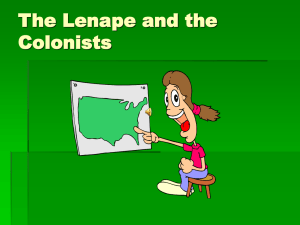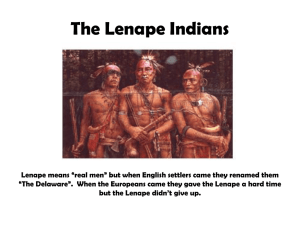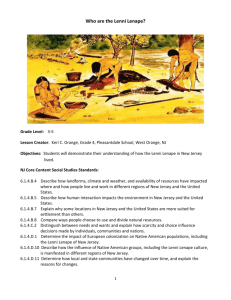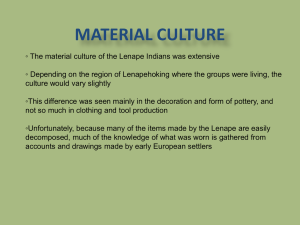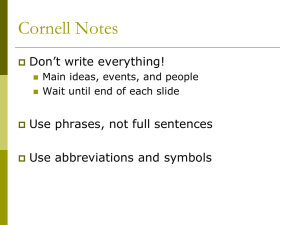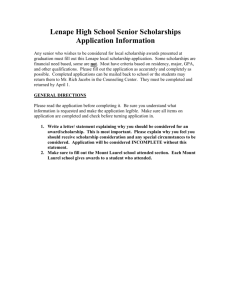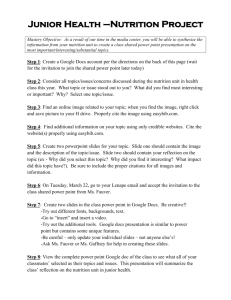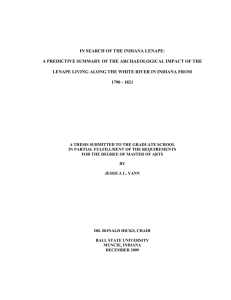Clothing and Decoration
advertisement
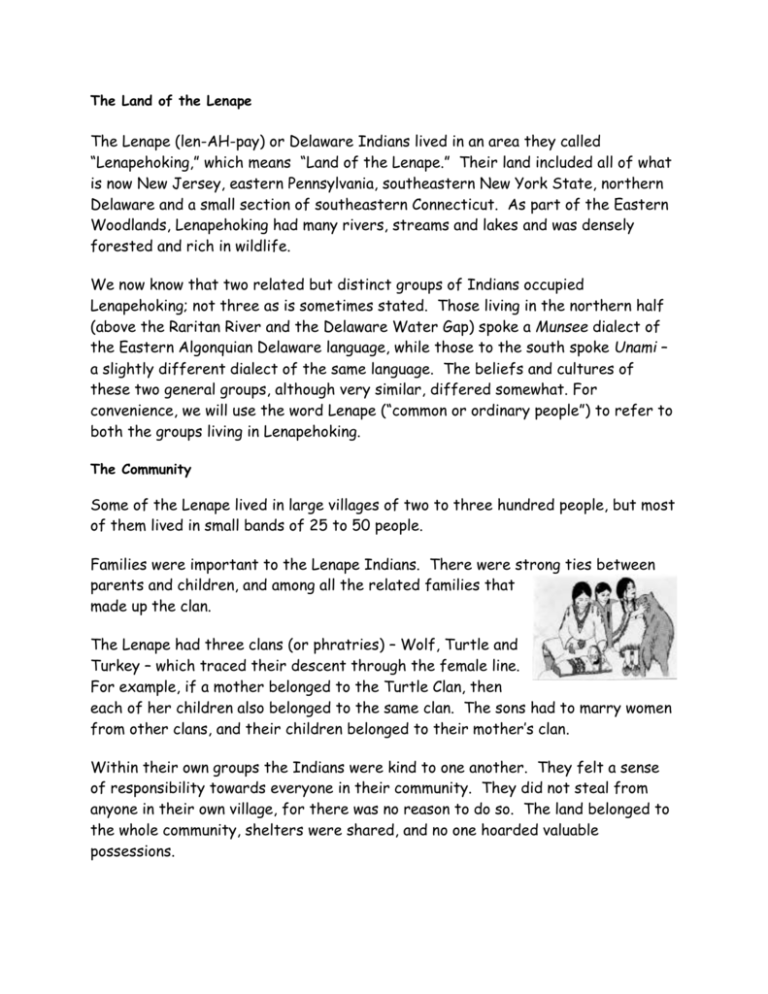
The Land of the Lenape The Lenape (len-AH-pay) or Delaware Indians lived in an area they called “Lenapehoking,” which means “Land of the Lenape.” Their land included all of what is now New Jersey, eastern Pennsylvania, southeastern New York State, northern Delaware and a small section of southeastern Connecticut. As part of the Eastern Woodlands, Lenapehoking had many rivers, streams and lakes and was densely forested and rich in wildlife. We now know that two related but distinct groups of Indians occupied Lenapehoking; not three as is sometimes stated. Those living in the northern half (above the Raritan River and the Delaware Water Gap) spoke a Munsee dialect of the Eastern Algonquian Delaware language, while those to the south spoke Unami – a slightly different dialect of the same language. The beliefs and cultures of these two general groups, although very similar, differed somewhat. For convenience, we will use the word Lenape (“common or ordinary people”) to refer to both the groups living in Lenapehoking. The Community Some of the Lenape lived in large villages of two to three hundred people, but most of them lived in small bands of 25 to 50 people. Families were important to the Lenape Indians. There were strong ties between parents and children, and among all the related families that made up the clan. The Lenape had three clans (or phratries) – Wolf, Turtle and Turkey – which traced their descent through the female line. For example, if a mother belonged to the Turtle Clan, then each of her children also belonged to the same clan. The sons had to marry women from other clans, and their children belonged to their mother’s clan. Within their own groups the Indians were kind to one another. They felt a sense of responsibility towards everyone in their community. They did not steal from anyone in their own village, for there was no reason to do so. The land belonged to the whole community, shelters were shared, and no one hoarded valuable possessions. Many of the groups inhabiting Lenapehoking had well-organized ways of governing their clans and villages. The chiefs – sometimes referred to as sachems - were chosen for their behavior, skill in speaking, honesty, and ability to make wise decisions. The chiefs also had to know about religion so that they could lead the people in rituals and ceremonies. War leaders were different. They gained power through proven bravery and success in battle. They were able to gather young men together and go off on a raid without the approval of the chief. Work between Men and Women Everyone worked, but men and women were expected to do different tasks. Starting at an early age, small children began to learn the skills they would need when they grew up. The boys were taught woodcraft and hunting; the girls, housekeeping and gardening. Women’s Work Women were responsible for the planting and harvesting of crops and gathering wild foods. Some of the crops were eaten as soon as it was harvested, but much of it - together with wild foods like berries, roots and nuts - were dried for winter use. The women pounded corn into flour by using a mortar and pestle. Nuts could be ground up and baked, or were pressed to squeeze out their oil, which was used in cooking. Maple syrup was made by collecting sap from maple trees in early spring and boiling it down. Women were skilled at making clay pots, weaving rush mats and bags, and making baskets. They wove cornhusks for slippers, mats and dolls, and made containers from elm and birch bark. With fibers from plants, they spun and braided cords for binding and carrying bundles. Women were also responsible for preparing the hides for clothes and shelters. With bone tools, they scraped the hair from the hides and cleaned them. Then they smoked them over a fire, cut them into pieces and sewed the pieces with bone needles. Men’s Work Men cleared the land, built and repaired the houses, and made dugout canoes by felling large trees and alternately burning and chopping through them to the desired shape. They constructed fishweirs and the large fish baskets to gather the catch. Using bows and arrows, the men hunted a variety of animals, although deer, elk and bear were the Lenape’s largest prey. Deer were often hunted by surrounding or herding them into pens or rivers. This method involved many people forming into a large a circle as possible and by using fire or noise to drive the animals to the hunters where they could be easily killed. Trapping was another means by which the Lenape caught animals like beaver, otter, muskrat, raccoon, mink and wild cats. Turkey, eagle and other birds like partridge, pigeon, wild ducks and geese were also shot or caught in traps to be part of the Lenape diet. Men were good warriors and sometimes had to go to war to defend their homes, but left the management of the house to their wives and often listened to the advice of the chief matron of his lineage in matters of peace and war. What kinds of homes did the Lenape live in? How did they dress? The Lenape made dome-shaped houses called wigwams where a small family or individual could live. They pushed a circle of poles into the ground and then bent them over one another to make a domed frame, which they covered with sheets of bark, skins or woven rush mats. Sometimes several families lived together in a larger “longhouse,” still rounded on top, but longer. Inside the longhouse were platforms of poles on either side that could be used as seats or beds. Down the center was a row of fires to share. Openings in the roof let the smoke out. Corn and herbs were hung high in the roof and there was room to store other goods beside the doorway. The Lenape lived in settled villages but did not stay in one place for the whole of their lives. Every ten or twelve years they had to move their entire village to a new site because they had used up many of the natural resources of their area. During the year, small groups might re-locate to temporary camps farther removed from the main village. Here they would stay for an indefinite time until they procured the desired materials or foods. Clothing and Decoration The Lenape dressed for snow and icy winds or for sticky heat, depending on the season. For men, light clothes would be a breechclout and leggings tied to a belt, and for women, a short, wrap-around skirt. Clothing worn next to the body was usually made of deerskin or beaver skin. In colder weather people added a hide shirt, fur robes, and perhaps mittens and fur caps. Everyone wore soft-soled deerskin moccasins. They kept themselves clean and were accustomed to a daily swim or used a sweat lodge or steam bath. The women wore their hair long and when working around fires, kept it in a braid or bun in the back of their head. For decoration, they might wrap their hair with a snakeskin or give their hair a gloss by applying bear grease. Young men often would cut their hair or pull it out by the roots so that only a small round spot on the crest of the head would remain. Although Lenape men did have sparse facial hair, most got rid of it by plucking it out. Men typically wore a hairpiece called a “roach,” made out of porcupine hairs and dyed deer hair. They might also wear feathers in their hair, but usually only about two – never the big war bonnets worn by the Plains tribes. The women used a type of red paint made from the bloodroot plant mixed with bear grease to put a round dot on each cheek, on their ears, and where they parted their hair. Men often painted their face, chest and shoulders. Men tattooed themselves with pictures of animals, birds, snakes or various geometric designs. Both men and women wore earrings, necklaces and hair ornaments from many natural objects like shell, bone, feathers, stones, clay, and animal claws and teeth. How did the Lenape eat? ashes. The Lenape had a great variety of food and believed that food was there to be shared. People were entitled to what they had trapped or gathered, but no one should be allowed to go hungry. Whenever visitors arrived, they were offered food. In turn, the guests always ate what was given to them. Food was cooked in clay pots over the fire or wrapped in leaves and set in the hot The Three Sisters The three most important planted crops were corn (also called maize), beans and squash, known as “The Three Sisters” by many Eastern Woodland tribes. Corn on the cob was boiled, baked, or fried in bear grease. Sometimes the women scraped the corn kernels off the cob, ground the kernels into a paste and shaped the paste into patties, which were then wrapped in leaves and baked or boiled. Corn was also used to make soup, bread, and puddings. Beans were boiled or fried, made into soups, or added to meat dishes. Squash was boiled or baked whole. Greens were added to meat dishes, wild herbs to soups, and berries to puddings or breads. Utensils consisted of bark plates or wooden bowls and spoons. Drying and Storing Plant foods were also stored away for the wintertime. Ears of corn were tied in bundles and hung from the ceilings of the houses to dry. Corn kernels and beans were removed and stored in skin or woven bags. Pumpkins and squash were cut into rings, put on a stick, and hung up to dry in the sun. Meat and fish could also be sun-dried or sometimes were placed over a smoldering fire to slowly smoke dry. As long as these foods were kept dry, they would not spoil. When a Lenape woman wanted to use dried food, she cooked it in water. The water made the dried food swell up and became soft enough to eat. Some Lenape women dug deep, wide holes or storage pits into the earth. Dried meat, dried fish, nuts and other dried edibles were placed in these storage pits. These subterranean storage areas were lined with mats or grasses to keep food free of dirt and keep out mice and other vermin. Stored foods enabled the Lenape to survive the cold winter. How did the Lenape entertain themselves? Games Not much is known about Lenape games and sport. Children’s toys usually consisted of miniature tools and weapons for the boys, and cornhusk dolls, small mortars and pestles, and toy pots for the girls. With these objects, children had fun and began to learn the skills they needed later in life. The Lenape also admired strength and liked to compete with one another in contests or games. Young men wrestled or tried to see who could throw a large stone the greatest distance. To be able to run fast was an important skill and so races were often held. Boys tried their skill with the bow and arrow, or with a pole that had to be thrown through a rolling hoop. The “cup and pin” game, made from deer toe bones and a stick, was a favorite pastime, and gambling appears to have been very popular. For this, pieces of bone or wild plum pits were painted on one side and then thrown into the air from a wooden bowl. Points were scored depending on how many of each color came up. In the moccasin game, one person would take four moccasins and hide something under one of them; the other players would have to guess where it was. Both males and females enjoyed team games. Lacrosse, a very popular sport among neighboring Indian tribes, may or may not have been played by the Lenape. A kind of football called Pahsaheman may also have been played. In this game, the ball was made of deerskin stuffed with hair and both men and women engaged, though the rules were different for each sex. Men could catch the ball but could not carry it or throw it; they had to kick it. Moreover, the men were prohibited from tackling or grabbing the women. Women, however, could catch the ball, run with it, pass it, or kick it, and they could tackle the men, sometimes tearing off their shirts. Music Musical instruments consisted of simple hide-and-water drums, bird bone whistles or possibly wooden flutes, and rattles made of turtle shell, bark, and gourds. Dancing accompanied by music and singing was a favorite pastime. Early writers noted that “the women, who always follow the men, dancing in a circle, act with decency and becoming modest … (but) the men shout and leap and stomp with such violence that the ground trembles under their feet” (Zeisberger 1910:118). Storytelling Stories were often fun to listen to and in winter people told stories to pass the time. But stories also served a serious purpose. Stories explained beliefs about creation, past events and social values and were an important part of a child’s upbringing. Children looked forward to long winter evenings by the fire, listening to the tales told by the Elders. Children were expected to be good listeners and have good memories.
